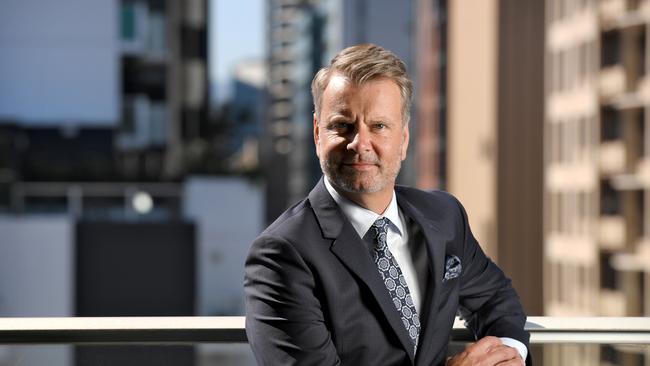Law Council president Morry Bailes says technology can boost access to justice
Law Council president Morry Bailes has the future of the legal profession top of mind.

SA Business
Don't miss out on the headlines from SA Business. Followed categories will be added to My News.
WHAT is the future of the legal profession?
It’s a question that, as president of the Law Council of Australia and managing partner of Adelaide law firm Tindall Gask Bentley, Morry Bailes has front of mind at the moment.
And with technological change already disrupting the industry and the Law Council increasingly concerned about those who are missing out on representation in our legal system, it’s an increasingly important question.
When it comes to technology and the changes it will bring to the profession, Mr Bailes is an optimist.
Much as technology swept through industries such as accounting and other professional services before it, there are some roles in the legal profession, or perhaps more rightly some tasks, which will be swept up in the wave of automation which has been sweeping the globe in recent years.
While this could be seen as a threat to jobs, it should be seen as an opportunity for lawyers to turn their minds to what their clients actually want from them – time spent on getting the outcome they are after, he says.
And on a broader social level, technological advancement, both through interconnectivity and potentially cost reductions, could lead to better representation for the many in our society – which the Productivity Commission in a landmark 2014 report dubbed the “missing middle” who do not receive adequate legal representation or miss out entirely.
It’s an issue the Law Council has taken up in its Justice Project – a comprehensive national review into the state of access to justice in Australia for disadvantaged people, to be released mid-year, which aims to expose flaws in the system of access to justice and identify systemic weaknesses and gaps.
Mr Bailes says the issues are interconnected, and technological change is an opportunity for the profession to evolve.
“Every time there’s a wave of technological change there is a chorus that might be described as overreacting, but equally I’m managing partner of a business that wants to stay at least with the curve if not ahead of the curve, and from a Law Council of Australia point of view, I have, as president during 2018, put an emphasis on looking at what we describe as the future of the law.
“It’s a very broad term and there are definitely comparisons that can be made with the future of professional services more widely.’’
Mr Bailes says issues such as “artificial intelligence” can be overdone, although there were certainly technological advances which were impacting strongly on the profession.
Companies such as Beagle, which offers a machine learning and big data application which can be used to rapidly search documents, are certainly impacting on what sort of work early-career lawyers might be asked to do.
“The catastrophist’s view about that is that those jobs will be gone and never return,” Mr Bailes says.
“I don’t personally share that view. I don’t see us as humans ultimately dealing ourselves out of the game.
“I see us probably moving on to doing different things . . . there are going to be winners and there are going to be losers but what concerns me from the point of view of the Law Council of Australia is that because we have a very broad profession, at one end large firms that are national or international and on the other side a cottage industry, I don’t want to allow to be left behind the majority of our profession who are sole practitioners and small partnerships when they play such a vital role in allowing people access to justice and access not only to the courts but to competent legal advice.’’
Mr Bailes, in his National Press Club Address in March, made the case for an extra $390 million a year – as a minimum in government funding to ensure all Australians receive adequate access to legal representation.
This followed the Productivity Commission calling for an extra $200 million in 2014 as an “urgent but only interim measure for civil law assistance alone’’.
“There are currently no national goals for the provision of legal assistance to a minimum percentage of the Australian population,’’ Mr Bailes told the Press Club. “Many people living below the poverty line simply miss out on legal aid. It also sometimes a simple issue of access.’’
Mr Bailes says a stark indication of the lack of access to the law in Australia was that about 30 per cent of Australians live outside major cities, but only about 10.5 per cent of legal practitioners practice in those areas.
“That could be cured by an approach at a government level where incentives are offered for rural lawyers to move to regional or bush areas and to stay for a period of time,’’ Mr Bailes says.
Mr Bailes says a lawyer is a key part of the business and, naturally, legal framework of regional economies and societies and regions are richer for having them there.
“There is certainly an attraction with technology that could unlock the challenge of providing access to justice and I don’t think that lawyers need to be scared about this because it’s probably people that wouldn’t be going to a lawyer for advice in the first place,” he says.
Mr Bailes says while the lack of access for the economically disadvantaged was a clear problem, the Law Council is also very concerned about the “missing middle: middle income earners who in reality can’t afford legal services, and there are ways in which technology may be able to help there”.
Mr Bailes also makes the point that legal aid must be well funded, as allowing unrepresented people to represent themselves in court was a false economy considering the inefficiency this causes.
Advances in technology also meant the profession needed to keep abreast of changes from a corporate governance perspective.
“The way I see technology is probably internal and external. There’s the internal application to the legal profession and the courts.
“In boardrooms around Australia I have no doubt that what partners and directors of law firms are talking about are the opportunities and threats externally which include things like cybersecurity risk which we need to deal with.
“We’re in a particularly precarious position because we have so much privileged material and ethical obligations that go along with that.
“We are exposed to the rising use of cryptocurrencies, both in terms of whether we should take them as fees or whether we should advise on them.”
Mr Bailes says he suspects those conversations, about issues such as cybersecurity, are not happening regularly enough.
Mr Bailes says there is also a valid question whether young lawyers have been undervalued in the past with their time used on mundane repetitive tasks, and handing that work off to technology could bring forth a lot of value.
He says some of the more mundane areas of law, such as simple contracts, could end up being “eaten up” by new technologies such as smart contracts but, again, this provided a role for practitioners to broaden their offering into higher value work.
“I don’t see that that firm or that person can’t reinvent themselves to add value and in fact it may be that they are the author of that program ... there are some promising legal start ups,” he says.
“What I’m convinced about is that providers in the legal industry will flourish.”


